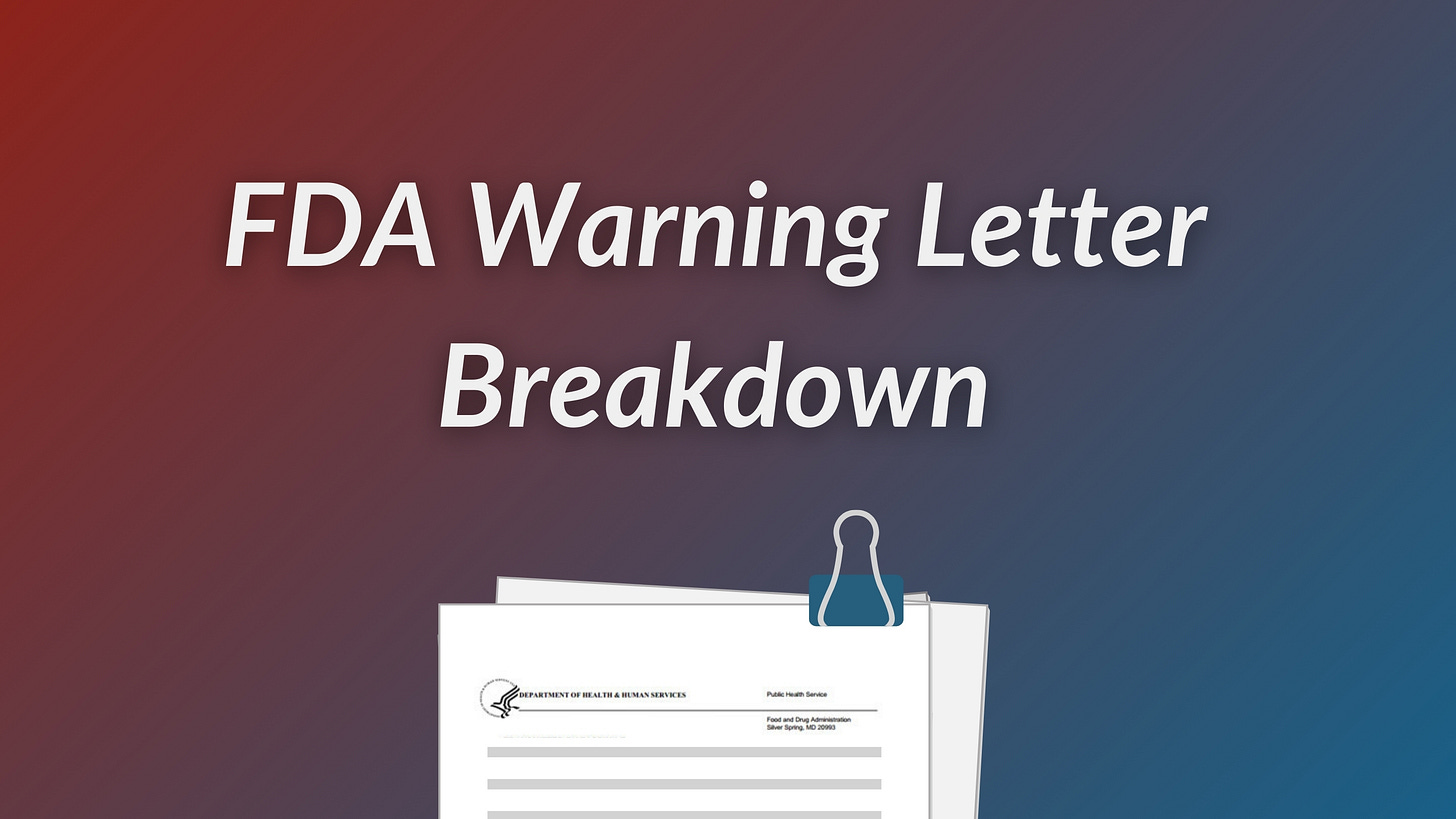FDA Warning Letter Breakdown: Quality Systems Fail at a Medical Device Manufacturer
A long list of deficiencies offers a ton of lessons for device firms on what the FDA is finding and citing.
This breakdown is available for paid subscribers. Only paid subscribers get regular full access to our breakdowns and other analyses. If you’re not already a paid subscriber, you can upgrade here.
It’s been a while since we analyzed an FDA warning letter in the device space, and a recently posted one offers several lessons for medtech firms that align with the issues we commonly identify in our audit work for clients.
Today, we’re examining a letter issued by the FDA's CDRH to a medical robotics company headquartered in San Carlos, California. The company’s primary innovation is a robotic-assisted bronchoscopy platform designed to enhance the detection and biopsy of lung nodules.
Read the full warning letter »
The warning letter resulted from an inspection conducted between October 28, 2024, and November 26, 2024, at the San Jose facility where they manufacture the bronchoscopes and accessories.
The FDA determined that the firm’s devices were adulterated within the meaning of section 501(h) of the Federal Food, Drug, and Cosmetic Act due to significant QSR non-compliance. Additionally, the devices were deemed misbranded under section 502(t)(2) for failure to meet MDR requirements.
This letter offers a glimpse into critical quality system failures that span multiple subsystems, including CAPA, complaint handling, design controls, nonconforming product management, and MDR reporting. What makes this case particularly noteworthy is the interconnection between quality system failures and their direct relationship to patient safety incidents.
Let’s break it down—and draw some lessons from it.
CAPA
The firm was cited for failure to establish and maintain procedures for corrective and preventive action. Its CAPA procedure required investigations "to a degree sufficient to determine the root cause," but the company failed to apply this standard consistently.
In CAPA 24-007, which addressed biopsy tools that couldn't pass through bronchoscope working channels, the company conducted a superficial investigation that failed to examine critical factors like lot-to-lot variation in the measurements of working channel distal ends.
More concerning was CAPA 23-005, which involved leaking sterile pouches during shelf-life testing. When packaging failed a subsequent aging study, the firm neither documented the new failure's cause nor referenced it in the original CAPA, demonstrating a concerning pattern of disconnected quality data.
The company's response included initiating a new meta-CAPA (24-028) and plans to hire third-party reviewers to assess all CAPAs, but critically lacked specific completion timelines for these remediation activities, making it impossible for the FDA to evaluate the adequacy of their response. (Note that this is exactly the kind of remedial work we’re typically called in to do.)
The lesson here is clear: Root cause investigations must be exhaustive, not expedient. When investigating any quality issue, manufacturers should deliberately challenge their initial hypotheses and explore all plausible contributing factors. This means asking not just "what happened?" but "why did this happen?" repeatedly until reaching fundamental causes that can be addressed through systemic corrective actions. This seems like a basic tenet of quality management, but it is something we consistently find lacking in our audit work with device firms.
Ask yourself:
Do our CAPA investigations consistently identify and document root causes with supporting evidence, or do we stop at the first plausible explanation?
How do we ensure investigations explore all potential contributing factors rather than focusing narrowly on the most obvious causes?
When similar failures occur across different products, lots, or time periods, do we systematically connect them to identify broader systemic issues?
Can we demonstrate that each CAPA was verified for effectiveness before closure, with objective evidence that the problem has been resolved?
Do our CAPA records include explicit timelines for completion and documented justification for any extensions?
Complaint management
The firm’s complaint handling system violated 21 CFR 820.198(a) through what FDA characterized as a consistent failure to properly investigate and document complaints, particularly those with patient safety implications.
Its procedure "Complaint Management" (SOP-025, Rev. G) required investigations to determine causes of product defects and malfunctions, but the company repeatedly failed to investigate critical device failures.
For example:
In Complaint #00003531 (failure to acquire live video feed), #00002229 (scope buckling due to kinking), and #00003614 (excessive patient bleeding with scope buckling), the company made no attempt to identify the underlying causes of these malfunctions.
More seriously, Complaint #00003610 involved a patient suffering pneumothorax (collapsed lung) during a Galaxy-assisted biopsy procedure, requiring chest tube insertion and hospitalization. Yet, the company failed to review batch records or any manufacturing data to determine if its device contributed to this serious injury.
Maybe the most concerning was Complaint #00003544, involving a patient death due to excess bleeding during a procedure. Despite indications that biopsy forceps may have punctured a blood vessel, the company made no attempt at further investigation when their Clinical Engineer couldn't determine causality from the procedure video.
To be clear, failures like this demonstrate a pattern of superficial complaint investigations that ignore manufacturing quality data, miss opportunities to gather critical information from complainants, and fail to track clinical outcomes for affected patients—all elements that are essential for an effective complaint management system in a high-risk medical device manufacturer.
Investigation depth must match the risk level. Complaints involving patient injury or death demand the most rigorous investigations, including systematic reviews of device history records, manufacturing data, and supplier quality information. Manufacturers should establish clear escalation criteria that automatically trigger deeper investigations when patient harm is involved.


